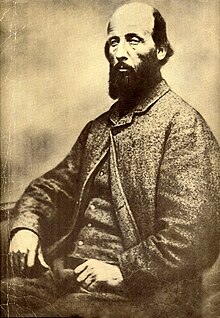Charles Fenerty
| Charles Fenerty | |
|---|---|

Charles Fenerty c.1870
|
|
| Born | c.January 1821 (DOB not known) Upper Sackville, Nova Scotia |
| Died | June 10, 1892 Lower Sackville, Nova Scotia, Canada |
| Residence | Nova Scotia, Canada, and Australia (living in different regions) |
| Nationality | Nova Scotian and Canadian |
| Occupation | farmer, writer (journalist articles), lumberman, lumber mill worker, Sackville church board, Wood Measurer, Census Taker, Health Warden |
| Known for | The invention of wood pulp for the production of paper |
| Spouse(s) | Anne Hamilton |
| Children | He had no children |
| Awards | Winner of the Nova Scotia Industrial Exhibition "Poetry Contest". The title of the poem: Betula Nigra. He also awarded for making "The Best Wood Laths in Nova Scotia". |
| Website | http://www.charlesfenerty.ca http://www.charlesfenerty.com |
Charles Fenerty (January, 1821 – 10 June 1892), was a Canadian inventor who invented the wood pulp process for papermaking, which was first adapted into the production of newsprint. Fenerty was also a poet (writing over 32 known poems). He also did extensive travelling throughout Australia between the years 1858 to 1865 (living in the heart of the Australian gold rushes).
Before wood pulp, paper was made from rags. Papermaking began in Egypt (see Papyrus) c.3000 B.C. In 105 AD, Cai Lun a Chinese inventor, invented modern papermaking using rags, cotton, and other plant fibers by pulping it. Then in the 18th century a French scientist by the name of René Antoine Ferchault de Réaumur suggested that paper could be made from trees. Though he never experimented himself, his theory caught the interest of others, namely Matthias Koops. In 1800 Koops published a book on papermaking made from straw. Its outer covers were made from trees. His method wasn't like Fenerty's (pulping wood); instead he simply ground the wood and adhered it together. His book does not mention anything to do with wood pulping.
Coincidentally, in around 1838 a German weaver by the name of Friedrich Gottlob Keller read Réaumur's report and got curious. Unaware of Fenerty across the ocean, he experimented for a few years and, in 1845, filed for a patent in Germany for the ground wood pulp process for making modern paper. This was the beginning of a very large industry that exists to this day. In that same year Henry Voelter bought the patent for about five hundred dollars and started making paper. Keller did not have the funds to do it. At one point he did not have sufficient money to renew his patent. Keller died poor, but well remembered in Germany as being the first to discover the process.
As a youth, Charles worked for his father in the family lumber mills. During the winter months the Fenertys would clear-cut the local forests for lumber (something Charles did not like). It would then be transported from neighbouring lakes to Springfield Lake (where their lumber mill was located). The lumber would then be hauled into the mill and cut up. The Fenertys would ship their lumber to the Halifax dockyards, where it was exported or used for local use (since Halifax was going through a "building boom" at the time). He had two brothers (he was the youngest boy), both of whom helped with the operations. Charles was also a farmer. The Fenertys had around 1,000 acres (4.0 km2) of farm land. They would ship most of their produce to the markets in Halifax. It was in his youth where he was inspired by both nature and poetry. His first (known) poem was titled *The Prince’s Lodge (later retitled as "Passing Away" and published in 1888). He was 17 years old when he wrote it. It was about the decaying home (overlooking the Bedford Basin near Halifax) that was built decades prior by Prince Edward Augustus, Duke of Kent and Strathearn. The lodge was in poor condition, and was not occupied as Prince Edward return to England in August 1800. He would have had passed this home every time he hauled his lumber and produce to Halifax. But he would pass the local paper mills too.
...
Wikipedia
